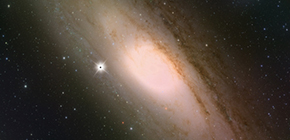
Dark matter turned out not to be primordial black holes!
An international team of researchers from Kavli Institute for the Physics and Mathematics of the Universe (WPI) of The University of Tokyo, Osaka University, Tohoku University, Princeton University, and the Inter-University Centre for Astronomy and Astrophysics, examined data on the Andromeda galaxy (located at about 2.6 million light year away from the Earth) via the Hyper Suprime-Cam (HSC), clarifying that dark matter (DM) in space between the Andromeda galaxy and the Milky Way was not likely to be primordial black holes (PBHs).
Using HSC, the prime focus camera mounted on the Subaru Telescope in Hawaii capable of capturing an image of the entire Andromeda galaxy (also known as M31) in one shot, the team explored the gravitational lensing effect by PBHs lighter than the mass of the Moon (or PBHs smaller than a 0.1 mm radius black hole with the same mass as the Moon), which had been speculated by the late Stephen Hawking. Their results have ruled out the possibility that PBHs smaller than a tenth of a millimeter make up most of dark matter.
In the universe, there is about five times as much DM as there is ordinary matter, but its identity has been unknown. There are two DM candidates: a) undiscovered elementary particles and b) black holes that may have formed in the early universe, or PBHs. In order to examine the possibility of the latter, the team focused on the Andromeda galaxy.
When a PBH cuts across in front of a star in the Andromeda galaxy (i.e., when the PBH and a star in the Andromeda galaxy are in alignment), the PBH causes the gravitational lensing effect to the star and variations in stellar brightness are observed. That is, a sudden dramatic increase in the brightness is seen as a PBH approaches the star in the Andromeda galaxy and the brightness subsides as the star moves out of alignment with the PBH. If there are many PBHs between the Andromeda galaxy and us, it is supposed that one can see microlensing events in which stars in the Andromeda galaxy become brighter due to gravitational lensing effect by PBHs for several tens of minutes.
The team obtained about 190 exposures of M31 for a period of about 7 hours on the night of November 23rd, 2014. The 8.2 m aperture and excellent image quality of HSC allowed the team to simultaneously monitor about 90 million stars, from which they detected variable stars. The team looked for gravitational lensing effect candidates, or stars that were consistent with the light curve, identifying only one gravitational microlensing candidate.
Their results have ruled out the possibility that PBHs smaller than a tenth of a millimeter, or light PBHs (one one-billionth of the solar mass, or one 30th of the lunar mass), make up most of dark matter. Moving forward, this joint international team will observe the Andromeda galaxy by HSC to develop the study to explore gravitational microlensing effects of PBHs.

Figure 1

Figure 2

Figure 3

Figure 4
The Article, “Microlensing constraints on primordial black holes with Subaru/HSC Andromeda observations” was published in Nature Astronomy at DOI: https://doi.org/ 10.1038/s41550-019-0723-1 .
Related links
